Celebrate the Mid-Autumn Festival with these classic Red Bean Mooncakes. Full and comprehensive recipe to make mooncakes from scratch with step-by-step photos.

Red Bean Mooncakes
The Mid-Autumn Festival is one of my favourite food celebrations, partly because autumn is my favourite season, and partly because I love the mooncakes which are gifted and eaten at this time of the year.
And ever since I started making my own mooncakes at home (they are very hard to find in Zurich), I have been hooked. I typically make Mooncakes with Lotus Seed Paste, but my kids love my Chocolate Fudge Mooncakes the most.
These Red Bean Mooncakes are a classic flavour which you can find in many Asian grocers in the lead-up to the Mid-Autumn Festival, and making them from scratch is much easier than it seems.
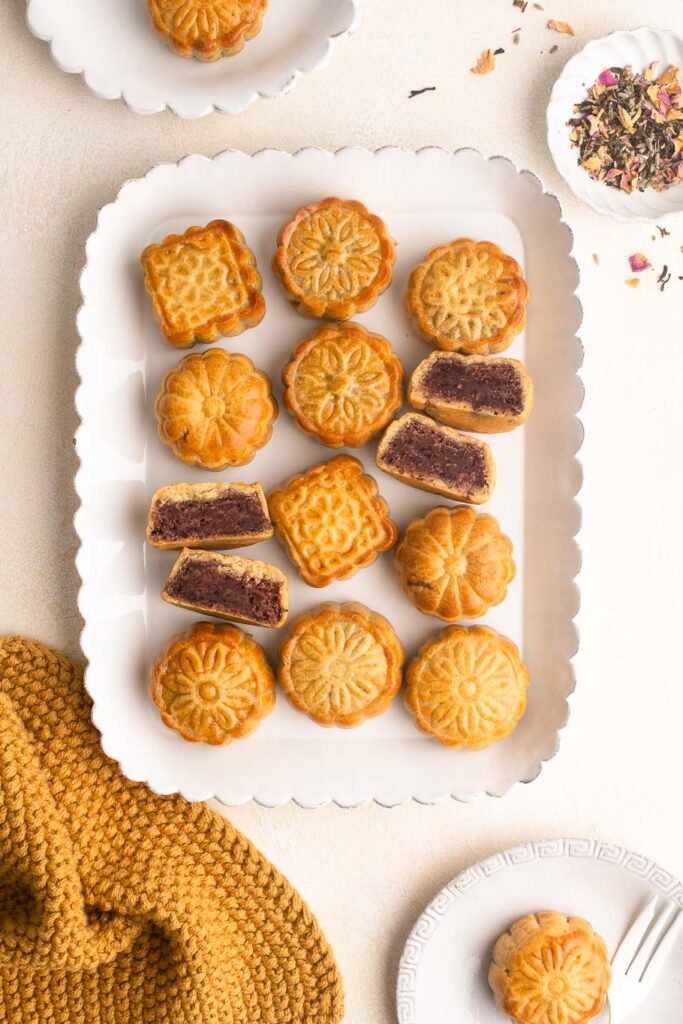
Homemade Mooncakes
If you live in a city with a thriving Asian community, chances are that you can find Asian grocers which will stock a variety of quality mooncakes in the lead up to the Mid-Autumn Festival. But in most European cities, you are lucky just to find an Asian grocer which stocks a decent selection of the pantry basics.
A few years ago, I would never have considered baking my own mooncakes. But once I gave it a try, and produced a beautiful batch on the first go, I have been happily making them ever since. Once you get over the initial unfamiliarity with the ingredients, the equipment, and the baking process in general, you will find that making homemade mooncakes is simply a series of easy steps.
Also, I happen to love eating the mooncakes fresh on the day that they are baked. Traditionally, the mooncakes are left to soften over 1-2 days. But now that I have tried eating freshly baked mooncakes with a crispy pastry, the taste is incomparable!
Mooncakes with Red Bean Paste
Red Bean Paste is used in many Asian cakes, bread and desserts. It typically provides a sweet contrast against more plain flavours.
Although I grew up eating Mooncakes with Lotus Seed Paste (perhaps because it was my mother’s favourite flavour and that’s all she bought), Red Bean Paste has a similar taste and texture.
Mooncake Moulds
The mooncake moulds I use for this recipe are cheap and cheerful sets which are readily available on Amazon.
I recommend buying a set with multiple moulds so that you have a variety of patterns to use, and also a combination of square and round moulds.
If you are trying to introduce young children to mooncakes (or any Asian cake, for that matter), it helps to have fun, cartoon shapes on hand to entice them. Although, I am rather impartial to the Hello Kitty moulds for myself!
The mooncake moulds come in a few sizes – 50 g for small mooncakes (generally a good portion for 1 person), or 100 g for large mooncakes intended for sharing.
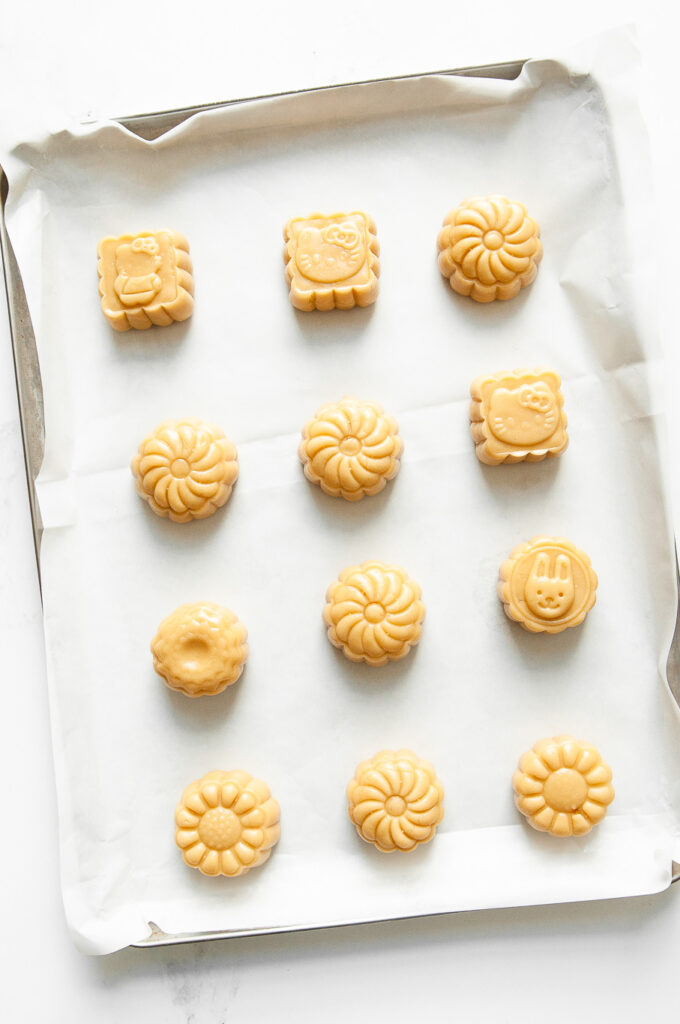
Mooncake Recipe
Mooncakes comprise of several components, namely:
- Making or buying the filling
- Making or buying the lye water (if this is not available where you live)
- Making the dough
None of these steps are particularly difficult, but they each take time. And because I live in Switzerland where many Asian ingredients are not available, I naturally have no choice but to make each component from scratch!
So my recipe below is a fairly detailed recipe where you can make every component of the mooncakes from scratch at home.
However, if you are able to easily buy red bean paste and lye water, then all you have to make is the dough which is pretty quick and easy in itself.
How to Make Mooncakes
How to Make Red Bean Paste
It is possible to buy ready-made red bean paste in some Asian grocery stores, but making your own means that it is fresher and with no preservatives added, plus you can control the sweetness of the paste.
To make your own Red Bean Paste, please see my recipe for Red Bean Paste with step-by-step photos.
How to Make Lye Water
Lye water is an alkaline water used in some recipes to help with texture or colour. For example, lye water gives pretzels their signature dark brown colour. For mooncakes, a small amount of lye water is used to give the dough a deep, golden colour.
Lye water is readily available in Asian grocery stores in some countries, but not in others. Due to its potency and irritant factor, lye water is even banned in some countries.
If you are unable to buy lye water, please see my recipe on how to make Lye Water with step-by-step photos.

How to Make Mooncake Dough
Please see full recipe instructions in the recipe card below.
This dough is fairly interesting in that it uses golden syrup for both moisture and sweetness. I don’t think you can substitute the golden syrup for another type of syrup, nor is it worthwhile if you want to create a mooncake which is both authentic in taste and texture.
I use Lyle’s Golden Syrup, which is commonly used in British and Australian baking recipes.
When making the mooncake dough, you want a mixture which is fairly soft and pliable. If the mixture looks too dry and crumbly, add a dash of water to try and bring the dough together. Otherwise, a dry dough will be difficult to roll out later to stretch and cover the filling.
When you roll out the dough, it should feel both sticky and oily.
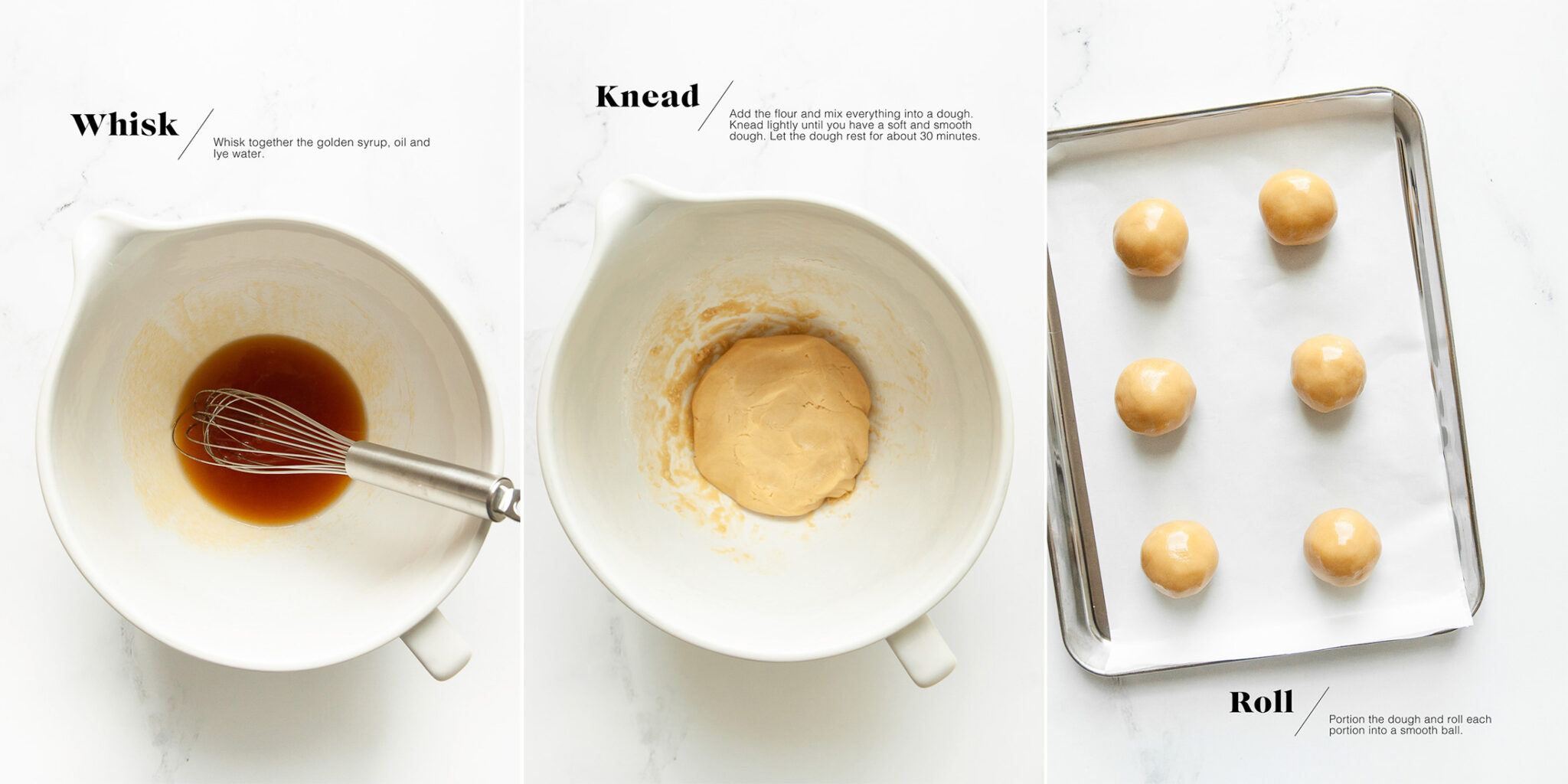
How to Shape the Mooncakes
Please see full recipe instructions in the recipe card below.
Mooncake moulds generally come in two main sizes:
- 50 g moulds – the filling should weigh 30 g, and the dough should weigh 20 g
- 100 g moulds – the filling should weigh 60 g, and the dough should weigh 40 g
You can play around with the ratio of filling to dough, but the total weight should be close to the size of the mould, otherwise the cake will not fit into the mould.
Depending on the consistency of your dough, you may need to dust your mould with some flour to prevent the dough from sticking.
It may take you a few attempts to know how much pressure to apply and when to release the mould, but you should get the hang of it pretty quickly.
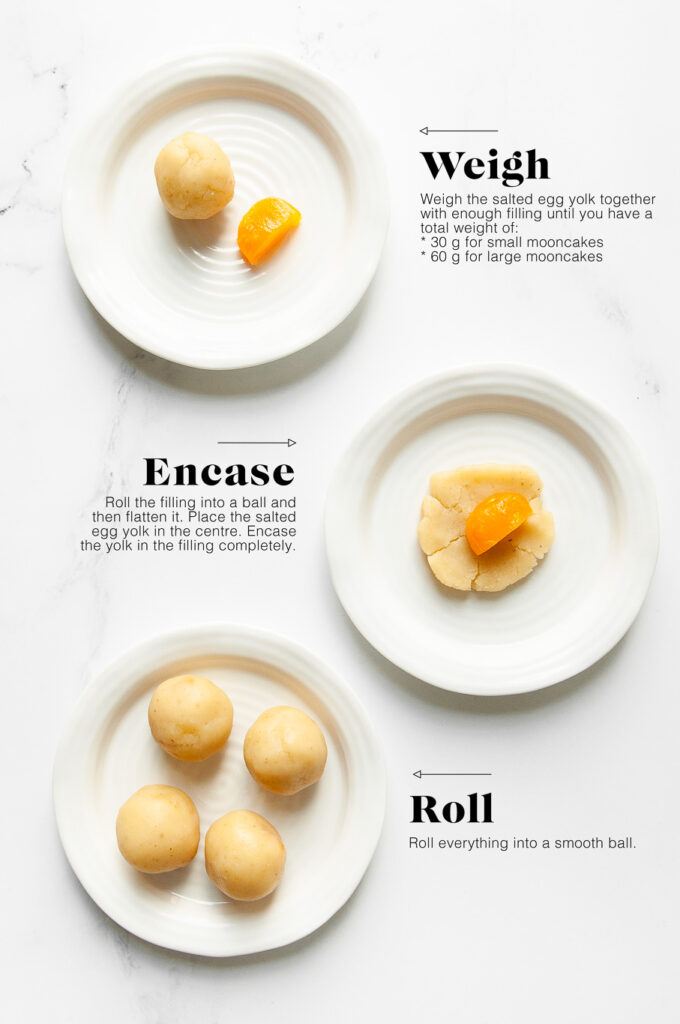
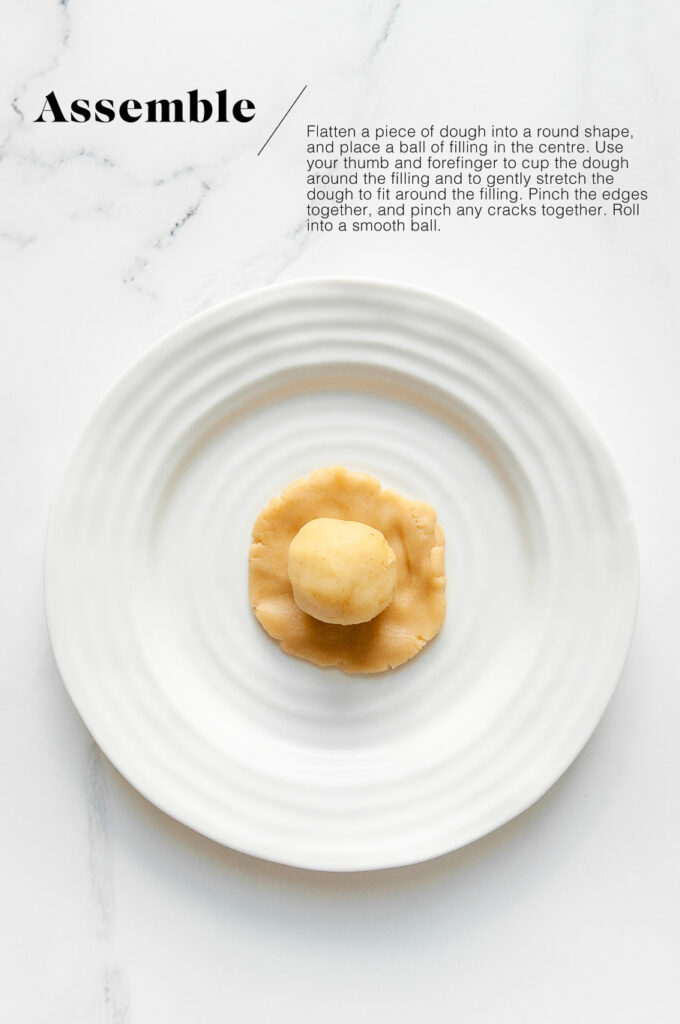
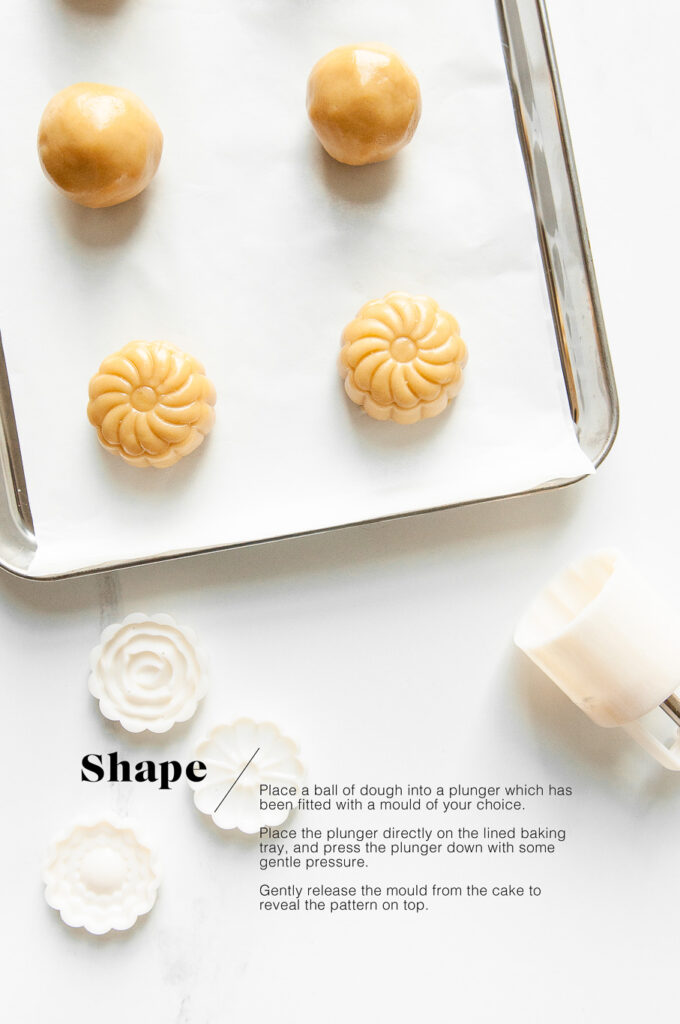
How to Bake the Mooncakes
Please see full instructions in the recipe card below.
Mooncakes need to be baked twice. The first bake is mostly to set the pattern before applying any egg wash. Otherwise, applying the egg wash first might prevent the patterns from staying in place.
After the first bake, you need to let the cakes cool slightly before applying the egg wash. If you apply the egg wash too soon, the egg might coagulate on the cakes and leave spots on the surface.
The egg wash should be brushed only very lightly on the cakes – you want just enough to moisten the dough and to help the cakes brown evenly. I recommend using a pastry brush with fine (natural) bristles which is better at applying the egg wash over the intricate patterns; a silicone brush generally picks up too much egg wash.
The second bake is to fully cook the mooncakes until they are golden brown all over.
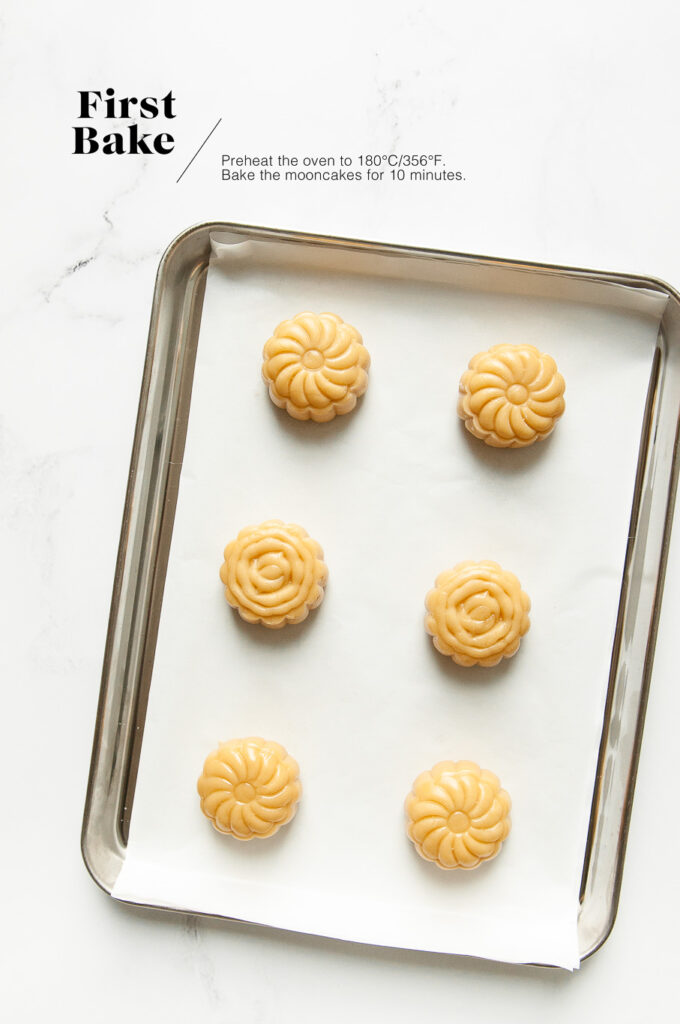
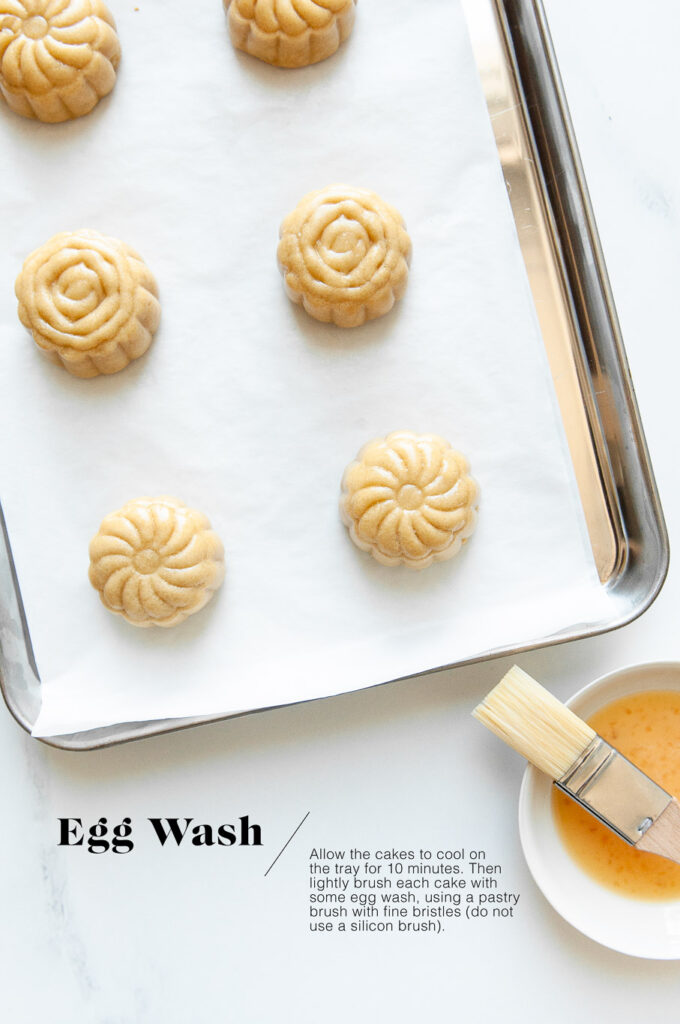

Tips for Making Mooncakes
Making mooncakes is an art form, and this is a recipe which requires a lot of patience and a bit of practice. It took me several attempts before I got the hang of it and understood how the texture and consistency of both the dough and filling should be.
My tips for making mooncakes are:
- Start at least the day before. None of the components of mooncakes are particularly difficult, but they all take a bit of time. Starting everything the day before will make you feel less stressed and rushed when it comes to making the actual cakes.
- Use a digital kitchen scale. Baking is culinary science, and science requires precision. When it comes to making mooncakes and ensuring that each ball of filling and dough is exactly the right size so that it can fit into the moulds, a digital kitchen scale will make life much easier. It will also help to ensure that your dough is made with the right ratio of liquid to flour.
- Experiment with different mooncake moulds. Some moulds look very beautiful but they don’t keep their defined lines once baked. I have a few fun moulds for the kids, including some Hello Kitty shapes, which I find to be too detailed to keep their form during baking. This could be due to a variety of reasons, but don’t be too disappointed if the cakes end up looking like little smooth buns – they will still taste great!
- Make a variety of fillings. If you have time, make a variety of fillings and use the same mould for each type of filling, so that you know what is inside. Not everyone likes salted egg yolks (especially kids), so I generally only make half a batch with salted egg yolks inside. Lotus seed paste is my favourite filling, but I also love red bean paste and chestnut paste. There are also many “modern” fillings that you can try, such as green tea paste and chocolate fudge.
- Use fun moulds for kids. Indulge the kids and use fun cartoon or animal-shaped moulds to entice them to try the mooncakes. Big kids (aka adults!) love the cute cartoon moulds too!
- Make a large batch. Given the time commitment required for making mooncakes, you may as well make 1-2 batches – they make great gifts for friends and family!
- Practice makes perfect. Like with most things in life, once you have made mooncakes once or twice, the process becomes less daunting. I find making mooncakes to be a bit like making specially stamped cookies.
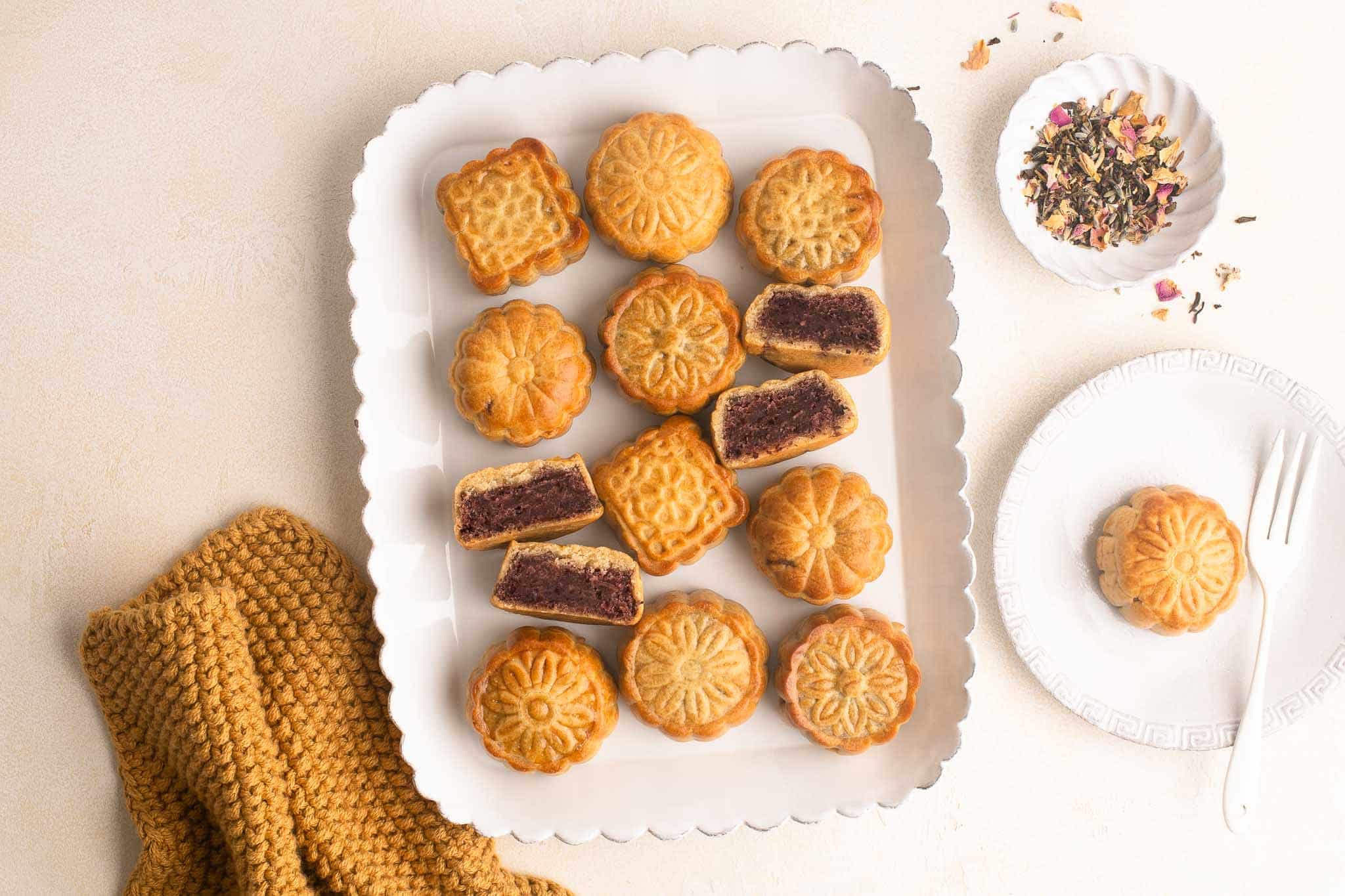

Red Bean Mooncakes
- Resting Time: 30 mins
- Prep Time: 1 hour
- Cook Time: 30 mins
- Total Time: 1 hour 30 minutes
- Yield: Makes 18-20 small mooncakes
- Category: Cakes
- Method: Oven
- Cuisine: Chinese, Vietnamese
Celebrate the Mid-Autumn Festival with these classic Red Bean Mooncakes. Full and comprehensive recipe to make mooncakes from scratch with step-by-step photos.
Ingredients
- approx 2 cups Red Bean Paste, ready-made or see recipe for Red Bean Paste
For the Mooncake Dough
- 150 g golden syrup
- 50 g sunflower oil (or another flavourless oil)
- 1/2 teaspoon food-grade lye water
- 225 g (1 1/2 cups) plain flour (all-purpose flour)
For the Egg Wash
- 1 egg
- 1 tablespoon water
Instructions
For the Red Bean Paste (see my recipe for Red Bean Paste with step-by-step photos)
- This step requires approx. 12 hours or overnight.
- If you are making the Red Bean Paste from scratch, start this step at least a day before making the mooncakes.
For the Mooncake Dough (this step requires approx. 45 mins)
- Make the Mooncake Dough on the day you plan to make the mooncakes.
- In a large mixing bowl, whisk together the golden syrup, oil and lye water.
- Add the flour.
- Mix everything together until a dough forms.
- Lightly knead the dough until you have a soft and smooth ball of dough. If the dough is too crumbly and doesn’t come together well, add some water.
- Wrap the dough in some plastic wrap.
- Leave the dough to rest at room temperature for at least 30 minutes.
To Prepare the Mooncake Filling
- For a 50 g mooncake mould, the filling should weigh 30 g (together with the Mooncake Dough of 20 g, the cake will weigh 50 g).
- For a 100 g mooncake mould, the filling should weigh 60 g (together with the Mooncake Dough of 40 g, the cake will weigh 100 g).
- Portion the Red Bean Paste as necessary using a digital kitchen scale.
- Roll each piece of Red Bean Paste into a ball.
To Prepare the Mooncake Dough
- For a 50 g mooncake mould, the Mooncake Dough should weigh 20 g.
- For a 100 g mooncake mould, the Mooncake Dough should weigh 40 g.
- At this stage, the dough should feel slightly oily and sticky.
- Portion the dough as necessary using a digital kitchen scale.
- Roll each piece of dough into a smooth ball.
To Assemble the Mooncakes
- Line a large baking tray with baking paper.
- Flatten a piece of Mooncake Dough into a thin round shape which is just large enough to encase the filling.
- Bring the edges of the dough up around the filling, cupping the mixture between your thumb and forefinger as you do so.
- Gently pinch the dough until it stretches to completely cover the filling.
- Pinch any cracks together, or even add a bit of extra dough to patch up any cracks if necessary.
- Roll the mixture into a smooth ball.
- Place the balls of filled dough onto the lined baking tray.
To Shape the Mooncakes
- Prepare the mooncake moulds by affixing your desired stamp to the plunger.
- It may be wise to lightly dust the moulds with some flour to stop the cakes from sticking to the stamps. But I generally find that the dough does not stick, especially if you are using the plastic mooncake moulds like I have.
- Place one ball into the mould. For square moulds, I recommend gently pushing the ball of dough into a squarish-shape with your fingers before inserting it into the mould.
- Place the plunger directly onto the baking tray, and press the plunger down with some gentle pressure. If you press down too hard, you might flatten the cakes too much.
- Gently release the mould from the cake.
- Repeat with the remaining balls of filled dough.
- The cakes do not spread as they bake, but I would still recommend spacing them apart so that they bake evenly.
To Bake the Mooncakes
- Preheat the oven to 180°C/356°F (without fan).
- Bake the mooncakes for 10 minutes.
- Remove the baking tray from the oven and let the cakes cool for 10 minutes.
- Reduce the oven temperature to 160°F/320°F (without fan).
- Meanwhile, make the Egg Wash by whisking the egg with some water in a small bowl.
- Lightly brush the mooncakes with the Egg Wash, using a pastry brush with fine bristles (a silicon brush picks up too much egg wash for this task). Try to avoid putting too much Egg Wash onto the intricate patterns on the surface. If you have too much Egg Wash on the cakes, use some kitchen paper to blot the cakes.
- Return the baking tray to the oven.
- Continue baking the mooncakes for 10-15 minutes, or until they are golden brown all over.
- Let the mooncakes cool completely on the baking tray, which will allow them to develop a crisp bottom.
To Store the Mooncakes
- Store the mooncakes in an air-tight container at room temperature for up to 1 week.
- The mooncakes are typically served after 1-2 days when the dough has softened slightly and the patterns become more settled and defined. However, I recommend trying at least one while it is still fresh and the dough is somewhat crispy.
- The mooncakes can also be stored in an air-tight container in the fridge. Bring the cakes to room temperature before serving.
Kitchen Notes
 USING SALTED EGG YOLKS
USING SALTED EGG YOLKS
Please see my recipe for Salted Egg Yolks with step-by-step photos. Also, please see my recipe for Mooncakes with Lotus Seed Paste for instructions on how to add Salted Egg Yolks to the mooncakes.
 OVEN TEMPERATURES
OVEN TEMPERATURES
All recipes on this website state temperatures for a regular oven (i.e. a conventional oven without fan). If you have a convection oven with a fan, please consult the manufacturer’s handbook on how to adjust the temperature and baking time accordingly.
 CONVERSIONS
CONVERSIONS
To convert from cups to grams, and vice-versa, please see this handy Conversion Chart for Basic Ingredients.

 Print
Print Pin Recipe
Pin Recipe Rate
Rate
I just made a batch of these mooncakes to practise before next week’s Moon Festival and wow, even I am impressed with what I have made! I used store bought red bean paste but I plan on making my own, now that I see how easy it is to make the pastry. Thank you so much for your recipe and excellent tips. Your website has by far the most comprehensive instructions on how to make mooncakes.
Hi Mimi,
Thank you for your lovely comment!
Very delicious mooncakes. I will be using this recipe every year for sure!
A labor of love but my mooncakes turned out very well. I don’t think I will every buy them from the store again!
Hi Sara,
I agree – they are definitely a labour of love! But they get easier the more often you make them 🙂
The red bean paste was not as sweet as the type you can buy in the shop, so I added bit more sugar. Also the color of the red bean paste was not the same. But the flavor was very good. I made a half batch of mooncakes today to try and they came out very well. I will make the rest tomorrow. The mooncakes become easier to make the more you practise.
Hi Ting,
Homemade red bean paste is more brown/grey in colour, but it tastes so much more delicious 🙂 I’m happy to hear that your mooncakes were a success!
Such a comprehensive recipe! I love your website. I can’t wait to make these mooncakes.
Thank you, Carmel!
Absolutely stunning mooncakes! They were intimidating to try and make at first but really easy once you get started. I used store bought red bean but I will try your recipe next.
Hi Aaron,
Thank you for your comment! Hope you will enjoy the red bean paste recipe too 🙂
I found mooncake moulds on Amazon for very cheap and gave your recipe a try. They were excellent!! Great tips in this recipe.
Thank you, Jonnie!
Just made the red bean paste. Going to freeze it and make the actual moon cakes a little closer to the mid autumn festival. Wish me luck.
Hi Varnamala,
I hope you will enjoy this recipe! Good luck 🙂